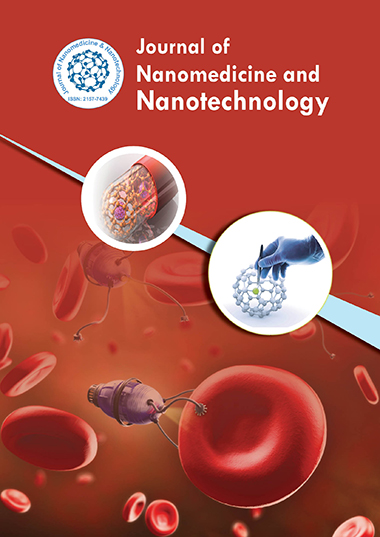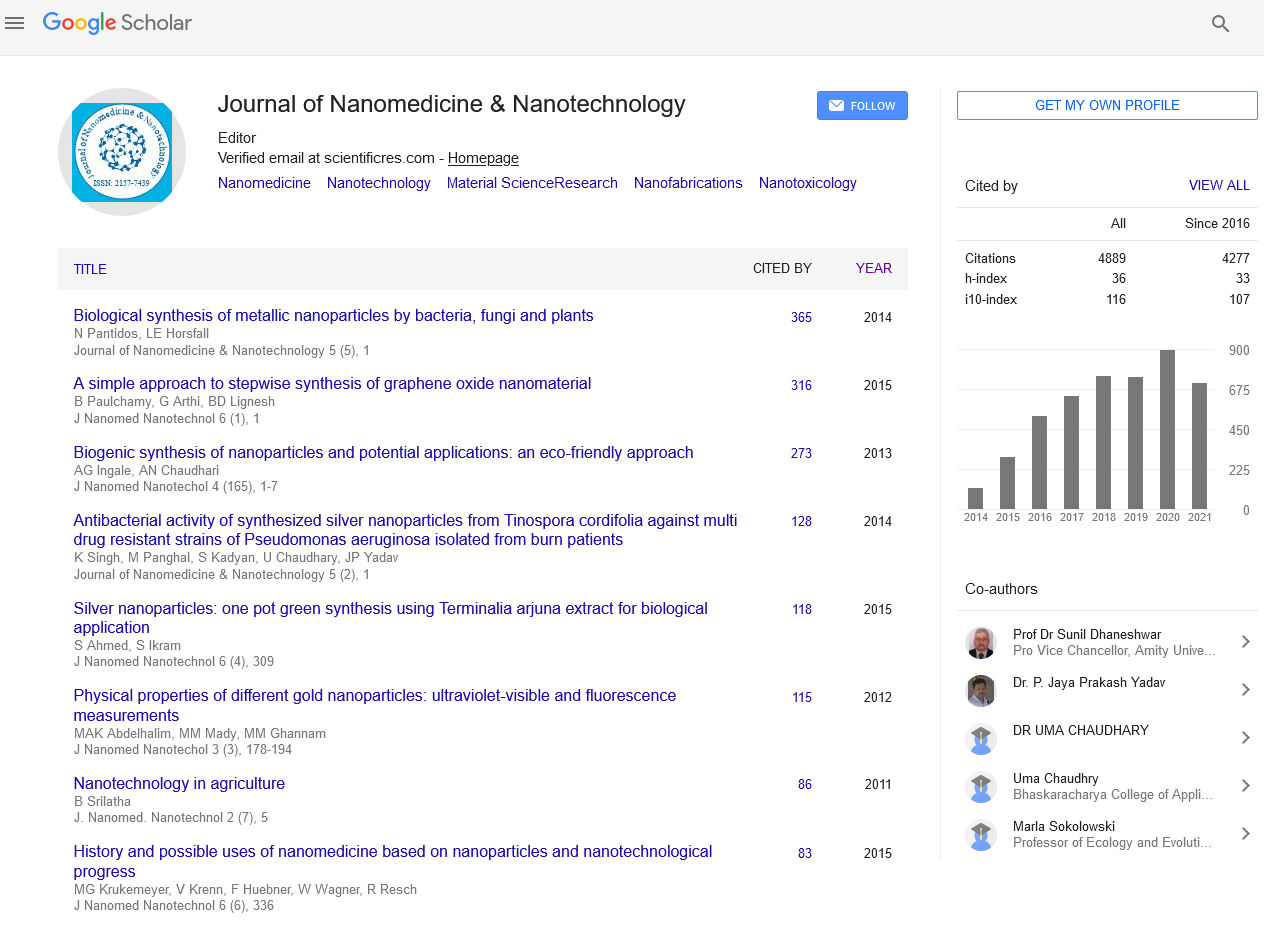Indexed In
- Open J Gate
- Genamics JournalSeek
- Academic Keys
- JournalTOCs
- ResearchBible
- China National Knowledge Infrastructure (CNKI)
- Scimago
- Ulrich's Periodicals Directory
- Electronic Journals Library
- RefSeek
- Hamdard University
- EBSCO A-Z
- OCLC- WorldCat
- SWB online catalog
- Virtual Library of Biology (vifabio)
- Publons
- MIAR
- Scientific Indexing Services (SIS)
- Euro Pub
- Google Scholar
Useful Links
Share This Page
Journal Flyer

Open Access Journals
- Agri and Aquaculture
- Biochemistry
- Bioinformatics & Systems Biology
- Business & Management
- Chemistry
- Clinical Sciences
- Engineering
- Food & Nutrition
- General Science
- Genetics & Molecular Biology
- Immunology & Microbiology
- Medical Sciences
- Neuroscience & Psychology
- Nursing & Health Care
- Pharmaceutical Sciences
Commentary - (2025) Volume 16, Issue 3
Investigating the Spatiotemporal Dynamics of Nanomedicines in Solid Tumors and Their Effect on Therapeutic Efficacy
Nourouzian Christa*Received: 23-Jan-2024, Manuscript No. JNMNT-24-34687; Editor assigned: 26-Jan-2024, Pre QC No. JNMNT-24-34687 (PQ); Reviewed: 09-Feb-2024, QC No. JNMNT-24-34687; Revised: 10-Mar-2025, Manuscript No. JNMNT-24-34687 (R); Published: 17-Mar-2025, DOI: 10.35248/2157-7439.25.16.787
Abstract
Nanomedicine has emerged as a promising frontier in cancer therapy, offering unparalleled precision in drug delivery to solid tumors. This article delves into the intricate world of investigating the spatiotemporal dynamics of nanomedicines within solid tumors and explores their profound impact on therapeutic efficacy. The journey begins with the administration of nanomedicines, navigating through the bloodstream to reach the tumor site. The interplay between nanomedicines and the dynamic tumor microenvironment is critical, influencing their penetration, drug release kinetics, and interaction with cancer cells. The targeted approach facilitated by nanomedicines enhances drug delivery to cancer cells while minimizing systemic side effects. The spatiotemporal characteristics also hold the potential to overcome drug resistance, ensuring sustained drug exposure. Incorporating imaging agents allows realtime visualization, enabling monitoring of treatment dynamics. Challenges persist in understanding and manipulating these dynamics, urging ongoing research to refine nanomedicine design and delivery systems. As we unravel the complexities of nanomedicine behavior within solid tumors, we open doors to more effective, targeted, and personalized cancer treatments, advancing towards a future where nanomedicine revolutionizes the landscape of therapeutic efficacy in oncology.
Keywords
Nanomedicine; Spatiotemporal dynamics; Solid tumors; Therapeutic efficacy; Drug deliveryDescription
In the realm of cancer treatment, nanomedicine has emerged as a revolutionary approach, offering the potential to enhance the precision and efficacy of therapeutic interventions. This article delves into the intricate landscape of nanomedicines within solid tumors, scrutinizing their spatiotemporal dynamics and the consequential effects on therapeutic outcomes. The quest for more effective and targeted cancer treatments has led to the forefront of nanomedicine, where the manipulation of materials at the nanoscale holds the promise of transforming the landscape of therapeutic interventions. In particular, understanding the intricate spatiotemporal dynamics of nanomedicines within solid tumors is a critical endeavor that stands to redefine our approach to cancer therapy. This article delves into the fascinating realm of nanomedicine, focusing on its journey within the complex environment of solid tumors and the consequential effects on therapeutic efficacy. Cancer remains one of the most formidable challenges in modern medicine, demanding innovative strategies to combat its complexity and heterogeneity. Nanomedicines, characterized by their nanoscale dimensions, offer a unique avenue for precision drug delivery and therapeutic interventions. As we embark on this exploration, it is essential to unravel the dynamic interactions between nanomedicines and solid tumors, as well as the temporal aspects that influence their behavior within the intricate landscape of the tumor microenvironment. The spatiotemporal dynamics of nanomedicines commence with their administration, typically through intravenous injection, navigating the circulatory system to reach the targeted solid tumors. However, the journey does not end there; it extends into the challenging microenvironment of the tumor, where factors such as irregular blood vessels, hypoxia, and interstitial fluid pressure pose hurdles that demand careful consideration. Understanding the effect of these dynamics on therapeutic efficacy is paramount. The precise targeting facilitated by nanomedicines has the potential to revolutionize cancer treatment by minimizing systemic side effects associated with traditional chemotherapy. Furthermore, the ability to release drugs in a controlled and sustained manner at the tumor site offers the prospect of prolonged therapeutic effects, potentially reducing the frequency of administration.
Understanding the spatiotemporal dynamics
Nanomedicine targeting: Nanoparticles employed in cancer treatment are designed to navigate the complex biological terrain and reach specific targets within solid tumors. The journey begins with the administration of nanomedicines, often through intravenous injection, where they circulate in the bloodstream, propelled by physiological factors such as blood flow and vessel permeability. Once at the tumor site, nanomedicines face the challenge of penetrating the tumor microenvironment to reach cancer cells effectively.
Tumor microenvironment: The spatiotemporal dynamics of nanomedicines are intricately linked to the tumor microenvironment, a complex ecosystem characterized by irregular blood vessels, hypoxia, and interstitial fluid pressure. Nanoparticles must navigate these hurdles to reach their intended targets. Understanding how nanomedicines interact with and respond to the dynamic conditions of the tumor microenvironment is crucial for optimizing their therapeutic potential.
Effects on therapeutic efficacy: Enhanced drug delivery: The precise targeting facilitated by nanomedicines allows for enhanced drug delivery to cancer cells while minimizing exposure to healthy tissues. This targeted approach mitigates systemic side effects associated with traditional chemotherapy, significantly improving the overall safety profile of cancer treatments.
Sustained drug release: The spatiotemporal characteristics of nanomedicines also influence drug release kinetics. Controlled and sustained drug release at the tumor site can lead to prolonged therapeutic effects, maximizing the drug's impact on cancer cells and potentially reducing the frequency of administration.
Overcoming drug resistance: Nanomedicines present an opportunity to address challenges associated with drug resistance in cancer treatment. By optimizing spatiotemporal dynamics, nanomedicines can potentially overcome resistance mechanisms, ensuring sustained drug exposure to cancer cells and enhancing treatment efficacy over time.
Imaging and monitoring: Nanomedicines often incorporate imaging agents, enabling real-time visualization and monitoring of their spatiotemporal distribution within tumors. This not only provides valuable insights into treatment efficacy but also allows for personalized adjustments based on the observed dynamics, optimizing therapeutic strategies over the course of treatment.
Conclusion
The investigation into the spatiotemporal dynamics of nanomedicines within solid tumors represents a crucial frontier in cancer research and treatment. As our understanding deepens, and technological innovations continue to evolve, the potential for nanomedicines to revolutionize cancer therapy becomes increasingly evident. By unraveling the intricacies of their journey within the tumor microenvironment, we pave the way for more effective, targeted, and personalized treatments, bringing us closer to a future where nanomedicine plays a central role in the fight against cancer. The precise targeting capabilities of nanomedicines offer a paradigm shift in cancer treatment, allowing for enhanced drug delivery to malignant cells while sparing healthy tissues from the harsh effects of traditional chemotherapy. By intricately navigating the tumor microenvironment, nanomedicines have the potential to overcome barriers that have traditionally hindered drug penetration and efficacy. The sustained and controlled release of therapeutic agents at the tumor site, guided by the spatiotemporal dynamics of nanomedicines, not only improves treatment efficacy but also introduces the possibility of reducing the frequency of administration. This not only enhances patient comfort but also contributes to optimizing therapeutic outcomes.Citation: Christa N (2025) Investigating The Spatiotemporal Dynamics of Nanomedicines in Solid Tumors and Their Effect on Therapeutic Efficacy. J Nanomed Nanotech. 16:787.
Copyright: © 2025 Christa N. This is an open access article distributed under the terms of the Creative Commons Attribution License, which permits unrestricted use, distribution, and reproduction in any medium, provided the original author and source are credited.


